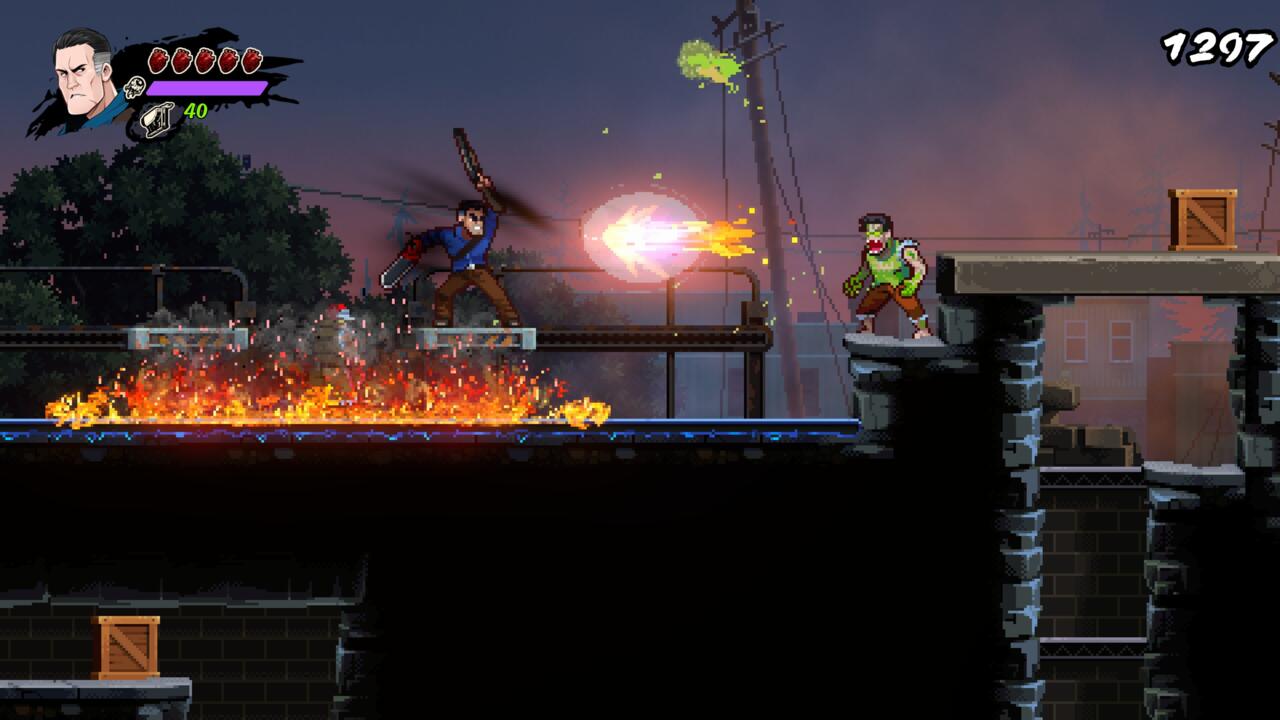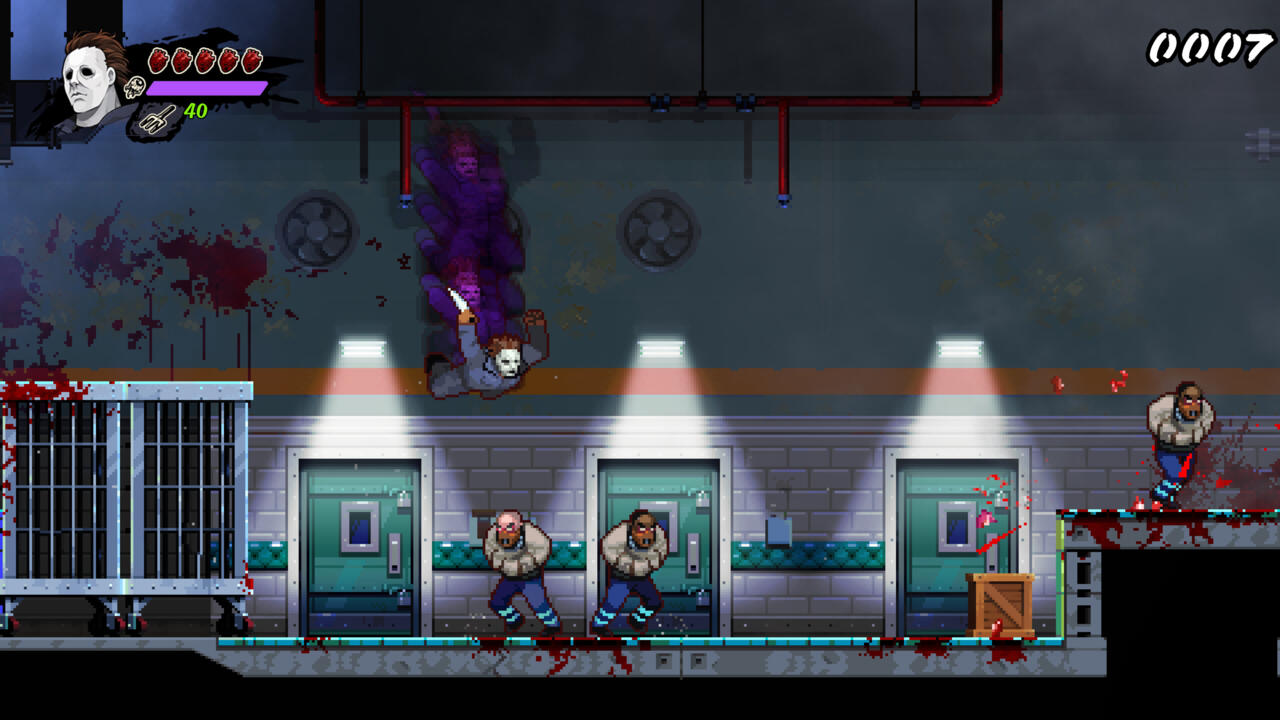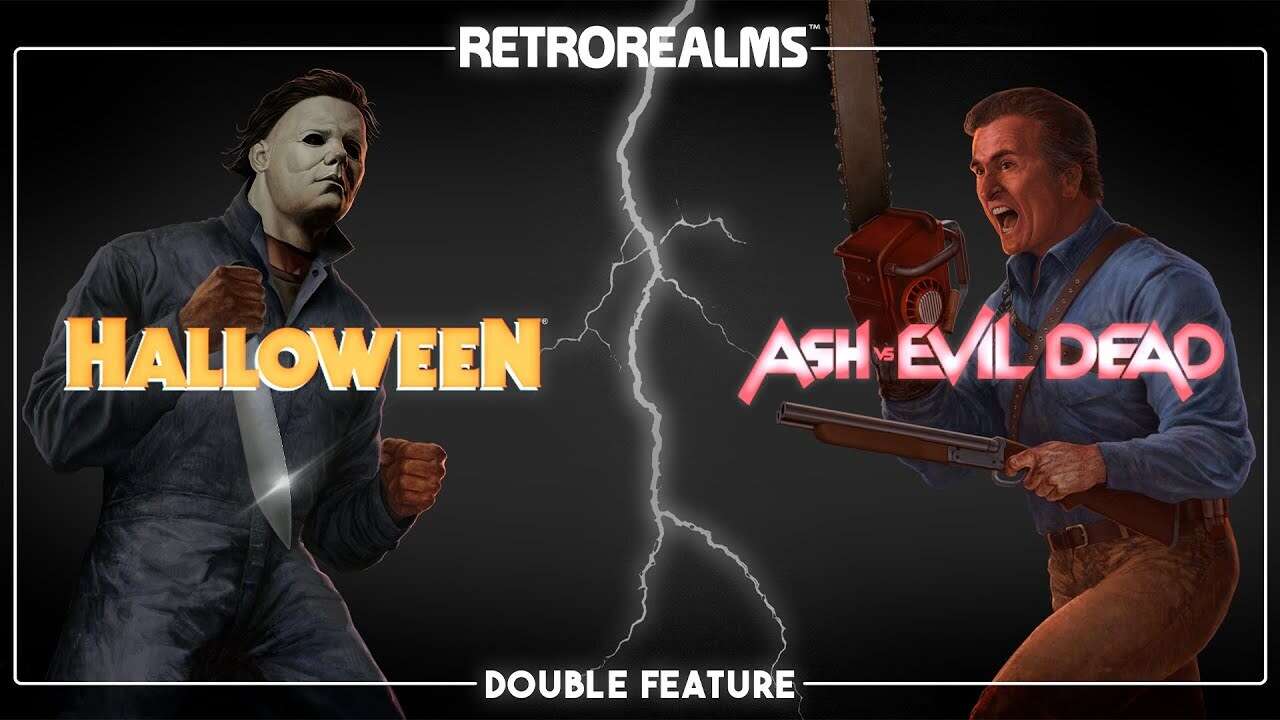Horror games based on beloved movies are more popular than ever, even when you compare this era to the early Nintendo years when movie tie-ins were a lot more common. But most of these modern takes on famous horror monsters have gone in the same direction, for better or worse. While everyone else is offering asymmetrical horror multiplayer games, RetroRealms turns back the clock to offer a package more in line with those horror tie-ins of decades ago, and thanks to some charming nods to horror history and pixel-perfect platforming, it’s an uncommon and intriguing ode to the horror genre.
As a product, RetroRealms is sold in a peculiar manner. RetroRealms Arcade is itself a free 3D hub space that you can explore in first-person, combining touches of a classic arcade with a horror museum. Within that space, you can purchase one or both 2D 16-bit platformers available at launch, Halloween and Ash vs. Evil Dead (AVED). For this review, I’ve played both games and used all current characters available.
Like Dead By Daylight, RetroRealms uses the idea of a demonic Big Bad, The Overlord, to bring its otherwise disparate worlds into one multiverse. The villain’s goal is a bit unclear and the story in general isn’t trying to be more than set dressing, with each playable character getting their own McGuffin to chase through any of the game’s multiple campaigns. The simple conceit paves the way to let you run through elaborate levels as Michael Myers, Ash Williams, and–if you buy additional character DLC–Laurie Strode from Halloween and Kelly Maxwell from AVED.
Because the game is a collaboration between Boss Team Games, a studio I recently learned is fully committed to licensed horror adaptations, and Wayforward, one of the best 2D game studios going today, RetroRealms shines in ways that exemplify what each team brings to the table. In the former’s case, this is expressed through the game’s explorable hub where you can unlock 3D versions of items seen in the game’s multiple campaigns, like Michael’s famous blue jumpsuit or his even more iconic mask. There are also several developer diaries you can unlock and watch, which I found appealing, though usually I wanted them to go longer or be more numerous. A cool one available right away goes into detail on how the game reimagined Halloween’s theme song–perhaps the most famous horror theme in movie history–for a retro-style video game.
Decisions like that, which allow the team to pull back the curtain and show players how things came to be, make for great rewards. Even the props in the museum, though they don’t do anything but look cool in their cases, are desirable collectibles to chase. Filling out the entire museum isn’t a feat I’ve yet accomplished, but it’s something I’m compelled to do as a big horror fan. I think there’s room to do more with these features, and given the teams’ intent to make RetroRealms a dynamic platform–at least two more horror franchises are coming to the game in the future, Boss Team told me–hopefully they’re expanded on to be even more interesting and numerous.
While the 3D hub serves as a constant reminder of the reverence the team has for the genre, the real star of this new horror multiverse is the platforming gameplay. Wayforward’s expertise shines in every corner of its levels, with vibrant pixel art full of details in the background and foreground, as well as tight traversal and combat mechanics that consistently challenged me.
Enemies fill every level high and low, and they each display obvious attack patterns that are nonetheless difficult to avoid. Some may throw a propane tank into the air roughly every three seconds, so you quickly learn to time your advance, but just ahead is a gross eyeball shooting sludge horizontally at you, while a platform nearby that you need to progress onward or use to grab an optional collectible overhead is rising and falling at such a speed that maneuvering through all obstacles and landing on it takes patience and perfection. But it’s all executable thanks to responsive and nuanced controls, like a jump ability that subtly extends your leap based on how long you hold the button down.
Across the board, the game’s animations are instructive as you learn to duck, ground-pound, and, most importantly due to its invincibility frames, dodge-roll like you’re the horror legends’ personal dance instructor. You’ll take note of how an overheard or ducked melee attack is slightly faster than a standing horizontal stab, which helps take down trains of enemies more quickly and without taking damage yourself. You’ll learn exactly how much distance you can cover with an air dash, or for how long you can hang on the side of a wall before you must launch yourself off of it. Every frame of the game matters. It’s all done with intent, and utilizing these subtle differences is often the deciding factor between success and failure.
Players who have longed for arcade experiences that are unforgiving but mechanically reliable will find a gem in RetroRealms. I died frequently, especially early on, but I never felt like the game was being unfair to me–it’s often ruthless, but it’s never cheating. I expect to enjoy watching high-level players take on these campaigns just as much as playing them myself.

Those tight mechanics are deepened further thanks to how each character has their own moves and abilities. Playing as Michael Myers, for example, isn’t going to feel the same as playing it as Ash Williams or Laurie Strode, even when the game allows you to bring them to each other’s worlds to see its multiple campaigns through new lenses. They may all be able to clear the gaps of the same size, but Michael does it with a single leap, while Laurie uses a double-jump ability, for example. Their skill trees further separate them, as you can create different builds, like one character that is especially hearty when it comes to health, allowing them to fight at close range, versus another who is loaded up with plenty of ammo for their ranged attack.
This will particularly appeal to the game’s speedrunning community that’s certain to arrive once it’s available, as different combinations of levels, characters, and abilities will surely be researched by players seeking to find the optimal builds to climb the leaderboards in a manner that harkens back to the arcade days much like the game does as a whole.
However, I find character progression to be one area where the game could’ve been less harsh. Upgrades are tied to campaign-specific save slots, not characters. For example, in one campaign, I’d upgraded Michael Myers a lot, giving him more health pips, more ammo for throwable items, and unlocking several skill moves that made combat easier. But when I took Michael into Ash’s world, none of those new toys came with him as it was considered a new campaign with a fresh character. This is one way in which the game adheres to a more punishing style from the ’90s that doesn’t seem vital to the experience. One could argue this keeps the leaderboards purer–I can’t speedrun an overpowered character on the first try; I have to earn a new OP character for a new campaign–but I think the alternative approach, in which you could max-out a character for a grueling challenge elsewhere is more enjoyable and still allows players to compete with the same rules governing all of them.
Similar to how characters are more than just skins, levels include an added layer that makes the game better. At any point, players can switch from the more earthly version of a level to the Dark Realm. The change is instantaneous and essentially makes every level behave like two levels. You can’t stay in the Dark Realm forever–an upgradeable timer ticks away and then demands a brief cooldown when it reverts you to the natural world–but you’d not want to stay in that realm forever anyway. As hard as the base levels can be, the Dark Realm is often harder, with more and heartier enemies who take more than the standard single hit to die.
Sometimes it’s vital to enter the Dark Realm, like when a blockage in the normal world disappears in favor of a fleshy, gross passageway in the Dark Realm. Other times, you may only want to visit it to check for collectibles, like tickets you use to buy items in the hub’s 3D museum. Flashing from one world into the other adds a layer of skill to a game already full of skill checks. It’s things like this that highlight how talented Wayforward is. The levels are great without this touch, but the team goes to the extreme to add depth, giving some mechanics the air of a victory lap from a team making it look easy.
Like the character progression, the game’s levels do exhibit one especially unforgiving element. Though checkpoints for when you fall off screen are fairly abundant, losing all your life resets the entire level back to the start. A popular modern convenience many games use is simply not to do this to players, and to allow a more generous checkpoint system that I’ve found to be the right approach. RetroRealms chooses to lean toward the old way of doing things, and that sometimes led me to take breaks from the game rather than fill me with the urge to give it the classic “one more try.”
Levels aren’t very long, but if you want to be careful and find all collectibles, they can stretch to 10 or 15 minutes each, so to wipe all of that in a game that is already quite hard often feels too taxing. Again, this seems like it’s designed with leaderboard purity at heart, but in that case, I think a compromise could be found in which players who use checkpoints don’t make it on the leaderboards but can still progress through the campaign.

Thankfully there’s a checkpoint before all boss battles, which are also quite challenging, though even then, if you’re struggling and wish to come back to the game later to try again, you’ll lose all level progress when you close the game. This isn’t a big deal on Xbox where the platform’s Quick Resume feature could bail you out, but on other platforms, you’ll more likely have to choose between keeping this checkpoint intact or playing something else when you feel like it.
A few retro-inspired design choices aside, it’s a great game overall, and the audiovisual experience is the blood-red cherry on top. Though none of the campaigns are truly retelling stories from their respective properties, the characters look so cool and well-realized–Ash even comes with Bruce Campbell’s crucial likeness–and each character is complete with diverse and sometimes funny idle animations. The worlds they inhabit are richly detailed to the point that even the game’s best speedrunners ought to slow it down on some runs just to take it all in. Things are always in motion, even when you can find a moment of respite away from all enemies who would do you harm, and the music feels like it arrived from a time machine set to 1994. Though I’m full of ’90s nostalgia that doesn’t typically extend to video games, RetroRealms blurs the line between being authentically retro and contemporary cool.
RetroRealms’ first two “cabinets” arrive in style with excellent platforming gameplay, an authentic ’90s vibe, and an interesting first-person 3D wrapper of a hub world that reminds you the game isn’t just mechanically tight; it’s also horror-obsessed. Boss Team and Wayforward prove to be a compelling tandem with this game, and given the team’s intentions to build out its arcade with additional famous (and sometimes masked) faces, I’m hopeful RetroRealms can go the way of the slasher series and get several sequels of its own.
